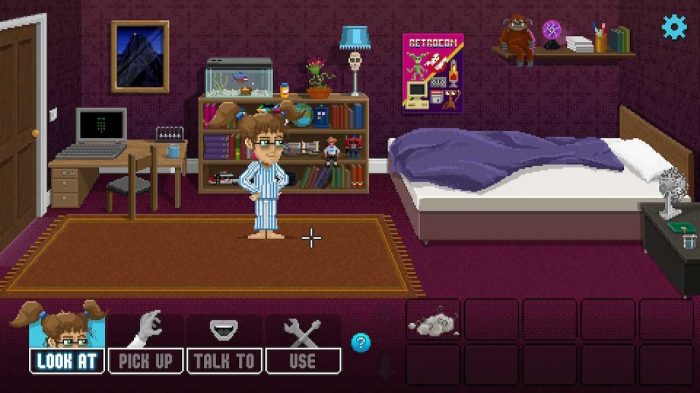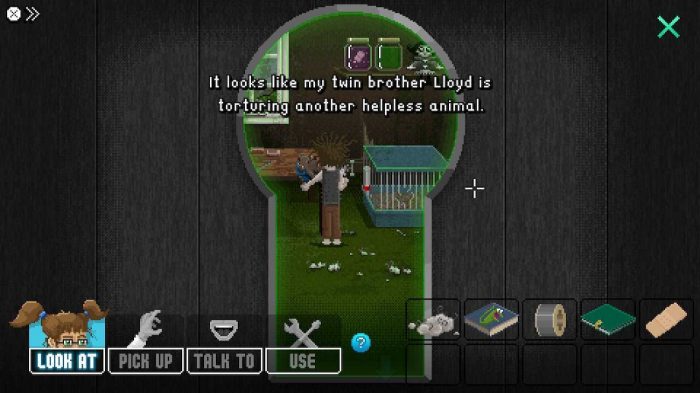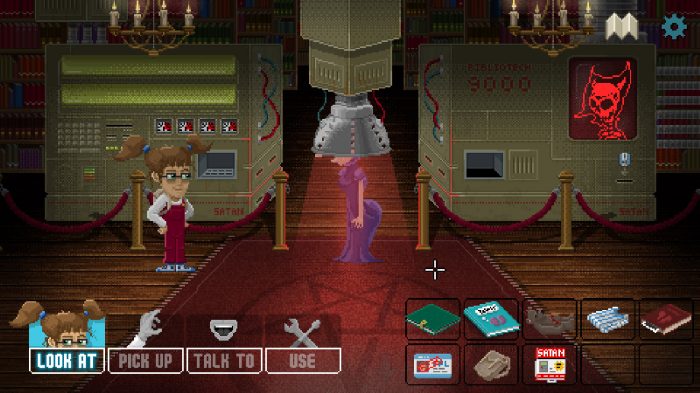Reviewed by Stuart Gipp
Generally, it takes a damn good jolt to knock me out of my stasis-level slumber when it comes to point-and-click adventures. It’s not that the genre is necessarily awful, just more than a little played out. Not only do many of the games work within the same exact gameplay framework and utilise the same mechanics, but the seemingly-obligatory humour is often exceptionally samey, with a somewhat corny American aesthetic. There are exceptions, of course; the Eric Idle-voiced Discworld games were a breath of fresh air let down only by ridiculous, illogical puzzles. Now, though, we have Lucy Dreaming, the most British point-and-click adventure game ever released. Hell, it may be the most British game ever released, full stop.

No doubt a huge part of Lucy Dreaming’s joyful Englishness stems from Emma Duckworth’s wonderful voice acting, giving every single one of what are surely tens of thousands of lines a lilting regional charm. That’s not to imply anyone else in the game’s lengthy story is any slouch – the whole thing sounds great and the fully-voiced proceedings lend a degree of polish to what is already a pretty impressive game. It’s all rendered in gorgeous pixel art, putting the recent Return to Monkey Island to absolute shame with beautifully and consistently drawn characters, objects, and backgrounds. There’s a rather glorious bleakness to the whole thing; yes, it’s highly stylised (calling to mind the comics of Ken Reid at times), but the relatively muted colours and exceptional bleakness of the real-world locations give it a sense of grit without compromising its sense of humour.

Real-world locations? No, not like that; you’re not going to be exploring anywhere you’ve been before unless you routinely dream of falling. See, the hook with Lucy Dreaming is a take on the somewhat familiar concept of travelling between two dimensions, or whatever you’d like to call them. Titular Lucy is able to flit between her waking world and her dreaming state in order to get to the bottom of why she suffers from constant nightmares. Cleverly, though, a compelling mystery exists within the constraining borders of reality, as well – a murder mystery, indeed, to juggle along with the night terrors. It’s an intriguing premise.
Every screen is absolutely festooned with “hot spots”, clickable items to investigate – and Lucy has a little quip or observation for each one. That may make the game sound a little too knowing, but its fourth-wall breaking is mostly reserved in tone, and its nods to geek culture and nerdy history are all characterisation rather than simply “Look! A thing from another thing!”

Interacting with it all is a pleasure, thanks to a simplified verb system consisting of Look At, Pick Up, Talk To, and Use. All the ingredients of a doomed relationship, but here applied gracefully for maximum puzzling power. As is typical of adventure games, there is some unusual logic to decipher at times, but thankfully the script is more than willing to offer hints for the curious. On a disappointing note, however, this could mean that seasoned adventure-heads find Lucy Dreaming a touch on the easy side. I didn’t find myself struggling with the ten or twelve hours it took me to finish the game, but it’s worth noting that a lot of that time would have been spent enjoying Lucy’s various reactions to experimenting with items and conversing with the large cast of memorable characters. One of which has a voice deceptively similar to that of a certain Guybrush Threepwood…

The sense I got from Lucy Dreaming is that it’s a game that respects its predecessors without being in thrall to them – as a result, you get something of the best of both worlds. The visuals and general game mechanics throwback to past Lucasarts and Sierra adventure games, but the puzzle design is, dare I say it, a step above. Moving around is no problem, too, with a world map allowing for instant travel to visited locations. Performance on Switch is great, making things feel all the more effortless. The controls are a slight misfire, with the analogue stick controlling your cursor and the A button “clicking”, with the D-pad letting you choose between verbs. You can also use the touchscreen, but of course, this is going to get smudges all over your lovely OLED. It’s entirely functional, but these games are very clearly intended to be played with a computer mouse. It’s also a bit of a shame that the HUD, as much as it would be incredibly disingenuous to call it bad, doesn’t tuck itself away a bit more. Then again, it is nice having everything available at all times, so it really depends on your personal preference.
Lucy Dreaming is a little throwback gem on the Switch that got several genuine out-loud laughs out of me. Even if you think the point-and-click genre is moribund, make sure you check this one out. It’s really rather good. Or, as Lucy might say, “I bloody love it, me!”
Lucy Dreaming £14.99
Summary
Lucy Dreaming is a refreshing new entry in the point-and-click genre, full of laughs and style. The bleak tone only strengthens the game’s core narrative, and though it’s an easy ride, it’s nonetheless one worth taking.

